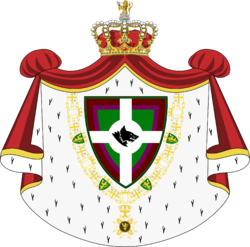Kingdom of the Fhainn
This article is a work-in-progress because it is incomplete and pending further input from an author. Note: The contents of this article are not considered canonical and may be inaccurate. Please comment on this article's talk page to share your input, comments and questions. |
The Kingdom of the Fhainn was a country located in northern Levantia on the northern coast of the Vandarch Sea. It was at various points an elective, absolute, and constitutional monarchy, and was a powerful challenger to the Holy Levantine Empire's expansion into Ultmar as well as an expansionist state in its own right. After a series of financial, military, political, and cultural disasters in the late 1800s, it was destroyed in a civil war in 1909.
Kingdom of the Fhainn Rihachd Fhainnlannachaeran | |||||||||
|---|---|---|---|---|---|---|---|---|---|
| December 7, 1398-February 7, 1909 | |||||||||
Motto: '' | |||||||||
| Capital | |||||||||
| Common languages |
| ||||||||
| Religion |
| ||||||||
| Government |
| ||||||||
| Rih Fhainnin | |||||||||
| Legislature |
| ||||||||
| Historical era | Renaissance / Early Modern | ||||||||
• Beginning of Màrtainn Dynasty | xxxx | ||||||||
| xxxx-xxxx | |||||||||
| xxxx-xxxx | |||||||||
| 1712-1717 | |||||||||
• Constitutional Monarchy formed | date, 1830 | ||||||||
| 1903-1909 | |||||||||
• Monarchy formally disbanded | 1909 | ||||||||
| |||||||||
| Part of a series on the |
| Kingdom of the Fhainn |
|---|
 |
| Timeline |
| Lua error in mw.title.lua at line 318: bad argument #2 to 'title.new' (unrecognized namespace name 'Portal'). |
History
Main Article: History of Faneria The history of the Kingdom of the Fhainn can largely be broken into the Early and Late Royal Eras. During the Early Royal Era, the Kingdom functioned as an elective monarchy, albeit with a dynastic succession enforced through blood ties, oaths of fealty, and strongarming. During the Princes' Wars, which were largely fought over succession as well as Protestant rights, this system was tested and broken; after the culmination of these, Faneria's monarchy became a hereditary position passed down by the appointment of a child or other familial heir. The Late Royal Era also includes the Constitutional reforms of 1830 which transformed Faneria into a nominally constitutional monarchy, as while significant social and political changes were permitted afterwards, the Royal Family spent the remainder of its rule attempting to claw back powers granted to the Senate and local governors and judges.
Establishment
Fhainnin politics of the Christian era were largely centered on the power struggles between Princes (Dochann), who were independent feudal overlords of various territories across the Ninerivers and eastern Vandarch regions. Many of these called themselves King (Rih) of their local region, but none claimed to be King of the Ninerivers, as that bore an implicit declaration of supremacy over the rest of the Princes.
The unofficial 'first Rih' of Faneria was Ruaridh Màrtainn, Prince of Cheatharnaich, a powerful principality centered on Cancale resting along the northern bank of Caileansriver buttressed to the north by the Deamhainn Mountains. Ruaridh had the good fortune, or perhaps planned, to inherit the city of Connsmonandún and the Principality of Mhartainnvail (then only Caileansdún and its surrounding regions, not the entirety of the modern province) from his brother and uncle, who were killed by a rival prince during a war over several vassal states. Ruaridh took the opportunity to expand his holdings, waging several wars of conquest against his own vassals to absorb their titles for himself.
Ruaridh's firstborn son, Rethys Màrtainn, crowned himself Rih de na Fhainn three years to the day after his inheritance, prompting a war between himself and the Principalities of Cionhaen, Dinan, and Brynmawr which became known as the Crown Wars. Rethys proved an able commander, in part due to a large contingent of veteran *ardceiternn* cavalry, and seize additional territories, vassalizing Dinan and Brynmawr and forcing Cionhaen to acknowledge his self-proclaimed title of "King of the Fhainn" in 1398.
Crown Wars
Early Expansions
Protestantism and the First Princes' War
Second Princes' War
New Administrative Model
- throneswatch, army, policing, and so on had existed but were often locally-run or haphazardly mashed together
Early Kin Wars and Sutharine Succession Crisis
Constitutional Monarchy
Industrialization
Republicanism and Revolution
Government
Vicarial System
Absolute Monarchy
Constitutional Monarchy
Administration
Royal Army
- army, duh
Throneswatch
- state intelligence, security, and bodyguarding
Royal Adjudicators
- law enforcement and early taxation
Royal Records and Tithes Administration
- first proper bureaucracy, taxes, records, and so on
Royal Command and Control Administration
- central organizing body for other Administrations====
Royal Mint
- money, official articles
Royal Works Administration
- infrastructure, engineering, public works and city planning
Royal Academies Administration
- arts and sciences patronage, cartographers and explorers, early colleges

